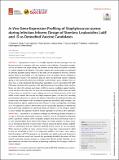Files in this item
In vivo gene expression profiling of Staphylococcus aureus during infection informs design of stemless leukocidins LukE and -D as detoxified vaccine candidates
Item metadata
| dc.contributor.author | Haag, Andreas | |
| dc.contributor.author | Liljeroos, Lassi | |
| dc.contributor.author | Donato, Paolo | |
| dc.contributor.author | Pozzi, Clarissa | |
| dc.contributor.author | Brignoli, Tarcisio | |
| dc.contributor.author | Bottomley, Matthew J. | |
| dc.contributor.author | Bagnoli, Fabio | |
| dc.contributor.author | Delany, Isabel | |
| dc.date.accessioned | 2023-01-24T16:30:09Z | |
| dc.date.available | 2023-01-24T16:30:09Z | |
| dc.date.issued | 2023-02-01 | |
| dc.identifier | 283069759 | |
| dc.identifier | 7958a227-30ce-474f-919b-bfc6f938b082 | |
| dc.identifier | 85148114354 | |
| dc.identifier.citation | Haag , A , Liljeroos , L , Donato , P , Pozzi , C , Brignoli , T , Bottomley , M J , Bagnoli , F & Delany , I 2023 , ' In vivo gene expression profiling of Staphylococcus aureus during infection informs design of stemless leukocidins LukE and -D as detoxified vaccine candidates ' , Microbiology Spectrum , vol. 11 , no. 1 , e02574-22 . https://doi.org/10.1128/spectrum.02574-22 | en |
| dc.identifier.issn | 2165-0497 | |
| dc.identifier.other | RIS: urn:D1075C5A9F230F7DAAE48FABB1C9E4CE | |
| dc.identifier.other | ORCID: /0000-0002-6783-0231/work/127573581 | |
| dc.identifier.uri | https://hdl.handle.net/10023/26822 | |
| dc.description | Funding: A.F.H. and L.L. were funded by Marie Sklodowska-Curie Intra-European Fellowships (PIEF-GA-2012-328377 and PIEF-GA-2013-623168, respectively). | en |
| dc.description.abstract | Staphylococcus aureus is a clinically important bacterial pathogen that has become resistant to treatment with most routinely used antibiotics. Alternative strategies, such as vaccination and phage therapy, are therefore actively being investigated to prevent or combat staphylococcal infections. Vaccination requires that vaccine targets are expressed at sufficient quantities during infection so that they can be targeted by the host’s immune system. While our knowledge of in vitro expression levels of putative vaccine candidates is comprehensive, crucial in vivo expression data are scarce and promising vaccine candidates during in vitro assessment often prove ineffective in preventing S. aureus infection. Here, we show how a newly developed high-throughput quantitative reverse transcription-PCR (qRT-PCR) assay monitoring the expression of 84 staphylococcal genes encoding mostly virulence factors can inform the selection and design of effective vaccine candidates against staphylococcal infections. We show that this assay can accurately quantify mRNA expression levels of these genes in several host organs relying only on very limited amounts of bacterial mRNA in each sample. We selected two highly expressed genes, lukE and lukD, encoding pore-forming leukotoxins, to inform the design of detoxified recombinant proteins and showed that immunization with recombinant genetically detoxified LukED antigens conferred protection against staphylococcal skin infection in mice. Consequently, knowledge of in vivo-expressed virulence determinants can be successfully deployed to identify and select promising candidates for optimized design of effective vaccine antigens against S. aureus. Notably, this approach should be broadly applicable to numerous other pathogens. | |
| dc.format.extent | 19 | |
| dc.format.extent | 3439146 | |
| dc.language.iso | eng | |
| dc.relation.ispartof | Microbiology Spectrum | en |
| dc.subject | In vivo gene expression | en |
| dc.subject | High-throughput qRT-PCR | en |
| dc.subject | Staphylococcus aureus | en |
| dc.subject | Staphylococcus aureus vaccine | en |
| dc.subject | Leukocidins | en |
| dc.subject | QR Microbiology | en |
| dc.subject | RA0421 Public health. Hygiene. Preventive Medicine | en |
| dc.subject | DAS | en |
| dc.subject | SDG 3 - Good Health and Well-being | en |
| dc.subject | MCC | en |
| dc.subject.lcc | QR | en |
| dc.subject.lcc | RA0421 | en |
| dc.title | In vivo gene expression profiling of Staphylococcus aureus during infection informs design of stemless leukocidins LukE and -D as detoxified vaccine candidates | en |
| dc.type | Journal article | en |
| dc.contributor.institution | University of St Andrews. School of Medicine | en |
| dc.identifier.doi | 10.1128/spectrum.02574-22 | |
| dc.description.status | Peer reviewed | en |
This item appears in the following Collection(s)
Items in the St Andrews Research Repository are protected by copyright, with all rights reserved, unless otherwise indicated.

